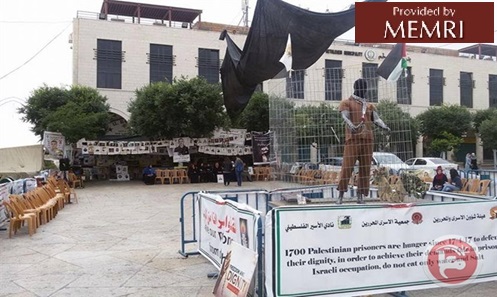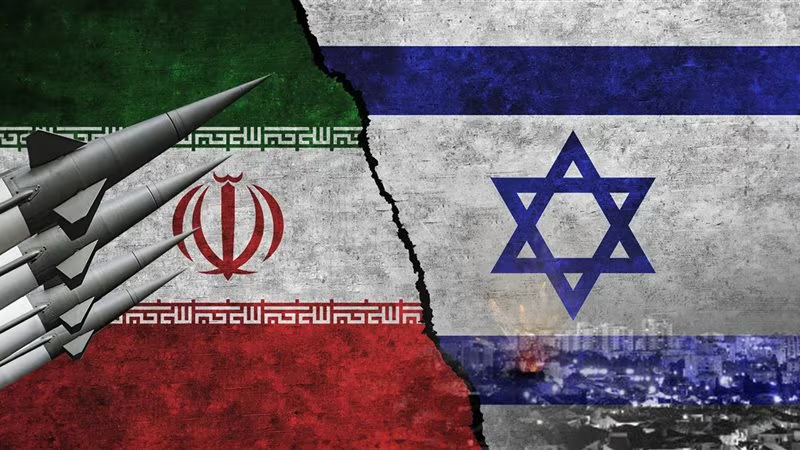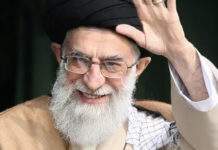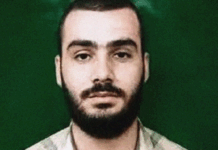Wprowadzenie
17 kwietnia 2017 r. około 1,5 tysiąca więźniów palestyńskich w więzieniach izraelskich rozpoczęło strajk głodowy pod przewodnictwem członka Komitetu Centralnego Fatahu, Marwana Al-Barghoutiego, który odsiaduje pięć wyroków dożywocia za morderstwo. Moment wybrania strajku, który zakończył się 41 dni później, 27 maja, był niewygodny dla Autonomii Palestyńskiej (AP), obawiającej się, że doprowadzi do gwałtownych zamieszek właśnie, kiedy prezydent Donald Trump gościł prezydenta AP, Mahmouda Abbasa w Białym Domu oraz podczas późniejszej wizyty Trumpa w Betlejem jako część jego starań o ponowne rozpoczęcie negocjacji palestyńsko-izraelskich. Kolejną trudnością, przed jaką stała AP, była obawa, że Al-Barghouti – który zainicjował ten strajk i go prowadził – przyjmie na siebie wyłączną zasługę, zamiast by zrobiła to AP i sam Abbas[1].
Niemniej, AP i Fatah nie mogli być obojętni wobec strajku, bo mogłoby to wywołać publiczne oburzenie i dlatego rozpoczęli kampanię poparcia więźniów. Kampania obejmowała: założenie obozowisk solidarności na całym Zachodnim Brzegu, które służyły także jako platforma dla przedstawicieli Fatahu i AP do wygłaszania przemówień i jako miejsca spotkań rodzin więźniów; działalność protestacyjna, taka jak strajk generalny, parady, deklarowanie dni wściekłości, blokowanie dróg i marsze do granicy z Izraelem i innych punktów starć. Również rząd AP pod kierownictwem premiera, Ramiego Hamdallaha, oznajmił otwartą sesję rządową na okres trwania strajku więźniów, a Rada Rewolucyjna Fatahu wezwała do nasilenia ludowego oporu. Także ministerstwo praw zagranicznych poinstruowało swoich przedstawicieli za granicą, by organizowali działania w solidarności z więźniami, zaś przedstawiciele Fatahu i AP wezwali delegatów międzynarodowych do naciskania na Izrael, by spełnił żądania więźniów.
Reakcja Autonomii Palestyńskiej na strajk głodowy więźniów ujawnia dwulicowość stanowiska Abbasa i AP wobec terroryzmu: choć starannie ogłaszają sprzeciw wobec przemocy i terroryzmu i potępiają akty terroru i ich sprawców na całym świecie, kiedy chodzi o więźniów palestyńskich w izraelskich więzieniach – z których olbrzymia większość skazana jest za terror, włącznie z mordowaniem cywilów izraelskich po porozumieniach z Oslo – AP gloryfikuje ich czyny, przedstawia ich jako bojowników o wolność i umieszcza ich sprawę na szczycie programu palestyńskiego. Pokazują to spotkania Abbasa z rodzinami więźniów[2], w tym z rodzinami terrorystów z krwią na rękach; przedstawianie sprawy więźniów prezydentowi Trumpowi podczas jego wizyty w regionie; proszenie wysłannika USA na Bliski Wschód, Jasona Greenblatta podczas jego spotkania z Abbasem 25 maja, by naciskał na Izrael w kwestii zgody na żądania więźniów; i wylewne chwalenie heroizmu i poświęcenia więźniów[3].
Gazety AP obszernie opisywały strajk głodowy, z nagłówkami na pierwszych stronach, obszernymi artykułami, zdjęciami i rysunkami, i przedstawiały więźniów jako ofiary, które wielce cierpią, nie wspominając o ich działalności terrorystycznej, która spowodowała cierpienia innych i zaprowadziła ich do więzienia. Codziennie „Al-Hayat Al-Jadida” informowała na pierwszej stronie o liczbie dni strajku głodowego, który nazwała Bitwą Al-Hurriya Wal-Karameh – tj. „Bitwą o wolność i honor „[4]. Ponadto promowano podnoszenie świadomości społecznej o strajku posunięciami takimi jak wzniesienie modelu więzienia na Placu Bożego Narodzenia w Betlejem w przeddzień wizyty Trumpa (patrz zdjęcia poniżej)[5]; władze miejskie w Ramallah ustawiły znak drogowy stopu z napisem “Stań wraz z więźniami”; a nawet młoda para odbyła ceremonię zaślubin w jednym z obozowisk protestacyjnych, by okazać solidarność z więźniami.
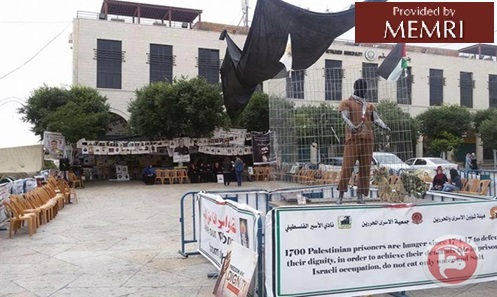 Model więzienia, kompletny, wraz z więźniem, ustawiony w centrum Betlejem przed wizytą Trumpa
Model więzienia, kompletny, wraz z więźniem, ustawiony w centrum Betlejem przed wizytą Trumpa
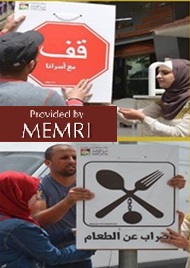 Znak stopu z napisem “Stań wraz z więźniami” i “strajk głodowy” (źródło: Akhbarelyom.com, 26 kwietnia 2017).
Znak stopu z napisem “Stań wraz z więźniami” i “strajk głodowy” (źródło: Akhbarelyom.com, 26 kwietnia 2017).
Wcześnie rano 27 maja, po 41 dniach strajku głodowego, przywództwo strajkujących więźniów z Al-Barghoutim na czele oznajmiło dyrektorowi Urzędu ds. Obywatelskich AP, Husseinowi Al-Sheikhowi, że strajk jest zakończony po osiągnięciu porozumienia w 20 godzinach negocjacji między przywódcami więźniów a Izraelską Służbą Więzienną w więzieniu w Aszkelon. Należy wspomnieć, że 10 przywódców więźniów, włącznie z Al-Barghoutim, przywieziono do więzienia w Aszkelon specjalnie w celu prowadzenia tych negocjacji.
Szczegóły porozumienia nie zostały jeszcze oficjalnie upublicznione, ale według oświadczenia przewodniczącego Urzędu ds. Więźniów AP, Issy Karake, więźniowie otrzymali spełnienie 80% swoich żądań, włącznie z pozwoleniem na wizyty ich rodzin dwa razy w miesiącu. Oświadczenie, które pojawiło się po rozmowie Al-Sheikha z Al-Barghoutim, stwierdzało, ze AP będzie finansowała drugą miesięczną wizytę dla rodzin więźniów kosztem 6 milionów dolarów. Należy wspomnieć, że postaci z całego palestyńskiego spektrum politycznego były zjednoczone w wyrazach zadowolenia ze strajku i szczęścia z tego, co postrzegali jako zwycięstwo dla więźniów w ich walce o poprawę warunków.
Wersje palestyńska i izraelska tego, co osiągnęli więźniowie, są rozbieżne. Według strony izraelskiej jedynym żądaniem, które zostało spełnione, było to o dodatkową wizytę w miesiącu, co będzie finansowane przez AP. W odróżnieniu od tego, strona palestyńska powiedziała, że więźniowie zdobyli kilka ulepszeń do wizyt rodzin, włącznie ze zniesieniem zakazu wizyt dzieci 140 więźniów; lepszą opiekę zdrowotną; i lepsze warunki dla nastolatków i kobiet[6].
Niniejsze opracowanie [nie spolszczone] jest przeglądem celów i motywów strajku na tle debat wewnątrz Fatahu; działań AP i Fatahu w kampanii solidarności z więźniami; gloryfikacji więźniów skazanych za terroryzm przez przedstawicieli AP oraz sprawozdań mediów AP ze strajku.
The Aims Of The Strike: Improving Conditions – As Well As Achieving National Goals, Launching A New Intifada
The official reason the prisoners went on hunger strike was to obtain improved conditions. The prisoners presented a long series of demands as conditions for ending their strike, including installing air conditioning, bringing in doctors from abroad and reinstating academic studies for prisoners. An official letter they sent to the Israel Prison Service listed the following demands: ending the policy of solitary confinement and administrative detention; improving the living conditions in prison by installing public telephones in all the prisons and wings so that prisoners can call their families, installing air conditioning and ventilation in the cells, reopening the prisoner-operated kitchens and bakeries in all the prisons and allowing prisoners to buy the groceries they need; improving visiting conditions by reinstating the second monthly visit that the Red Cross stopped, including for Gaza residents, not denying visits to first-degree and second-degree relatives, extending visiting hours by 45 minutes, allowing prisoners to be photographed with their families once in three months, building public facilities for the families at the entrance to the prison, allowing children and grandchildren under 16 to attend every visit, and allowing visitors to bring prisoners books, newspapers, clothes and other personal items; improving healthcare by closing down the hospital in Ramleh Prison which, according to the prisoners, does not provide adequate medical care, providing regular medical checkups, reducing the waiting period for operations, bringing in specialists from abroad, releasing ill and especially handicapped prisoners, exempting prisoners from healthcare payments, returning prisoners directly to the prison following medical treatments outside it without delays and providing food along the way; providing suitable conditions for transporting women prisoners and allowing them to meet visitors face to face (without a barrier); reinstating Open University studies and allowing prisoners to take the official matriculation exams.”[7]
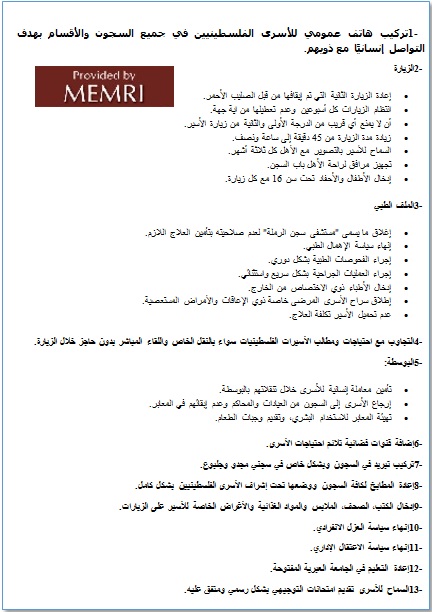 The document listing the prisoners’ demands (source: ynet.co.il, April 4, 2017)
The document listing the prisoners’ demands (source: ynet.co.il, April 4, 2017)
However, Palestinian officials and columnists in Palestinian papers and websites mentioned additional aims of the hunger strike. According to them, the primary aim was to increase solidarity with the prisoners and precipitating a new intifada that would bring about the end of the occupation. Qadura Fares, chairman of the Palestinian Prisoners Club, warned that the hunger strike would lead to an intifada first in the prisons themselves and later throughout the Palestinian territories.[8] Jordanian columnist Hamada Far’ana likewise wrote that Marwan Al-Barghouti was acting to start an intifada.[9] Former Palestinian MP and the administrator of the Amad website Hassan 'Asfour described the strike as a new intifada.[10]
The second aim mentioned was internationalizing the issue of the Palestinian prisoners and thereby changing their status, causing them to be seen as prisoners of war rather than terrorists. Indeed, from the beginning of the strike Palestinian officials acted to enlist the international community in pressuring Israel to comply with the prisoners’ demands and thereby to defuse the Israeli and American demand that the PA halt payments to prisoners. In a meeting with Al-Barghouti’s wife, Palestinian President Mahmoud 'Abbas promised her he would act in the international arena to „save the prisoners’ lives.”[11] Marwan Al-Barghouti’s son Qassam said that protests were taking place in the Palestinian territories alongside the diplomatic activity vis-à-vis foreign consuls.[12]
However, despite these efforts, the bid to rebrand the prisoners in the eyes of the international community – as prisoners of war rather than terrorists – was not successful.
Yet another aim of the strike was to achieve unity within Fatah as well as between Fatah and Hamas. In an April 16 letter to the Fatah movement, Al-Barghouti wrote that the movement was facing a challenge but also an opportunity to present a united position by Fatah prisoners and thereby increase their prominence, to end all the negative phenomena that have plagued Fatah in recent years, and to bolster its strength, unity and role.[13] As for unity between Fatah and Hamas, Palestinian researcher Ahmad 'Issa wrote that „the prisoners’ strike will inevitably impact the Palestinian dialogue on the [Fatah-Hamas] schism, which is at its worst.”[14] However, the refusal of Hamas prisoners to join the strike reduced the chances of achieving Hamas-Fatah unity, which were slim to begin with.
Controversy Regarding The Motivations For The Strike, Against Backdrop Of Struggles Within Fatah
From the beginning of the strike, some questioned the motivations of its initiator, Fatah Central Committee member Marwan Al-Barghouti, as well as the number of prisoners actually participating in it and the extent of support for it in the PA, in Hamas, in other Palestinian factions and among the Palestinian public at large.
It should be recalled that Marwan Al-Barghouti has been mentioned as a Fatah candidate to succeed 'Abbas as PA president.[15] In elections to the Fatah Central Committee held on February 2017, following the Seventh Fatah Conference, Al-Barghouti won the largest number of votes, reflecting his popularity. In light of this achievement and despite being in prison, he hoped to be nominated as Fatah deputy chairman, but he was not selected for this role or for any other role in the committee. His wife Fadwa claimed that 'Abbas had submitted to Israeli pressures not to nominate him.[16] Fatah official Nasser Al-Qidwa explained that there had been no consensus in the committee in favor of the nomination, and another Fatah official said that the Central Committee members had conspired against Al-Barghouti, just as they had earlier conspired against Muhammad Dahlan and his associates and excluded them from the movement.
Claims that personal ambition to succeed 'Abbas had led Al-Barghouti to launch the hunger strike in order to gain more popularity sparked a heated controversy in the PA. Fatah official and former PA official Mundhir Irshid said that Al-Barghouti’s exclusion from any official position in Fatah had prompted him to launch the strike in order to demonstrate his prominence and prove that nobody should ignore his ability to sweep the masses as he did in the second intifada.[17] Conversely, other former PA officials and columnists in PA papers, such as Ashraf Al-Ajrami and 'Abd Al-Ghani Salameh, argued that the humanitarian character of the prisoners’ demands belied the claim that Al-Barghouti had launched it out of a desire to bolster his status after failing to secure the role of Fatah deputy chairman. They also argued that a popular and genuine leader like Al-Barghouti did not need to strengthen his image by launching a strike.[18] Hafez Al-Barghouti, the former editor of the PA daily Al-Hayat Al-Jadida, wrote that the video which seemed to show Marwan Al-Barghouti eating during the strike had been fabricated and circulated by Fatah members because „he had become a rival to many of his [former] friends [in Fatah] and they feared his release from prison.”[19]
It should be mentioned that much praise was lavished during the hunger strike on Marwan Al-Barghouti, whom Palestinians regard as their Nelson Mandela although he was sentenced to five life sentences plus 40 years for orchestrating deadly terrorist attacks. PA Prisoners Authority chairman 'Issa Qaraqe’ said: „The leader Marwan Al-Barghouti is very popular not only among the prisoners and the Palestinian masses, but also with foreign human rights organizations, and has become one of the world’s [iconic] freedom fighters.”[20] Rajab Abu Suraya, a columnist for the PA daily Al-Ayyam, wrote that the scope of the strike – which involved about a fourth of the prisoners – was an achievement of the prisoners’ leadership, headed by Al-Barghouti, and that this achievement came after the prisoners had despaired of the PA government or of Hamas ever achieving a deal to affect their release. He added: „Just as the Fatah movement constituted the first shot and the first stone, and just as Fatah Central Committee member Mawan Al-Barghouti was part of the leadership of the first intifada in 1987, commanded by historic leader Khalil Al-Wazir, [aka] Abu Jihad, and just as [Al-Barghouti] was the patron of the second intifada led by the Father of the Palestinians, Yasser Arafat… he has [now] sparked off the intifada that is on the horizon, and none is more qualified to lead it than he. The knight [Al-Barghouti] will step up and receive the [Palestinian] banner. That is certain at this stage of the national struggle.”[21]
Media affiliated with Mahmoud Dahlan and with factions opposing 'Abbas, such as Hamas and the Popular Front, took advantage of the strike to praise Al-Barghouti and attack 'Abbas.[22] It should be mentioned that Muhammad Dahlan was excluded from the Fatah movement along with his associates, and this is the source of a bitter rivalry between him and Mahmoud 'Abbas. The exclusion of Dahlan, and later of Marwan Al-Barghouti, created a sort of alliance between the two, and Dahlan has explicitly declared that he supports Al-Barghouti as 'Abbas’s successor.[23]
Reactions To The Strike In Fatah, PA, PA Press: Glorification Of The Prisoners, Including Those Who Murdered Israelis
’Abbas: The Prisoners Are Our Heroes And Their Problems Are At The Top Of Our Agenda
As mentioned, although PA officials did not initiate the strike, they joined the expressions of solidarity with it and publicly identified with it, describing the prisoners as „icons” and „heroes” even though some of them perpetrated some of the gravest acts of terror Israel has experienced. In his May 2 meeting with representatives of the Palestinian diaspora in the U.S., 'Abbas said: „I say to the prisoners: 'Patience, your victory will come in time, you are our icons and our heroes.'”[24] On April 28, at the Muqata’a in Ramallah, 'Abbas received a delegation from the families of the martyrs and the hunger-striking prisoners. During the reception, 'Abbas met with Latifa Abu Hamid, mother of four Palestinian prisoners who are serving cumulative life sentences in Israeli prisons for their involvement in suicide and shooting attacks perpetrated against Israelis. Among them are Nasser Abu Hamid, who was a senior member of the Al-Aqsa Martyrs Brigade in Ramallah during the second intifada and was actively involved in the lynching of two Israeli soldiers in Ramallah on October 12, 2000, and Sharif Abu Hamid, who was also active in the al-Aqsa Martyrs Brigade, and provided weapons and assistance to perpetrate terror attacks in Jerusalem and Tel Aviv during February and March 2002.[25] During the meeting 'Abbas stated that „The prisoner problem is at the top of the Palestinian agenda.”[26] 'Abbas called upon the public to support the prisoners and relieve their suffering, clarifying that „The Palestinian leadership is in contact with international bodies to pressure the government of Israel to meet the demands of the prisoners.”[27]
'Abbas made similar statements at a meeting of Fatah’s Revolutionary Council on May 25: „We will support the prisoners and prevent them from being forced to surrender or to back down. Our heroic prisoners are striking for humanitarian purposes.”[28]
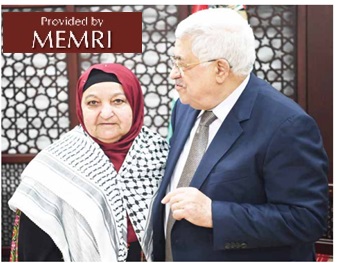 ’Abbas’s meeting with Latifa Abu Hamid (image: Al-Hayat Al-Jadida, April 29, 2017)
’Abbas’s meeting with Latifa Abu Hamid (image: Al-Hayat Al-Jadida, April 29, 2017)
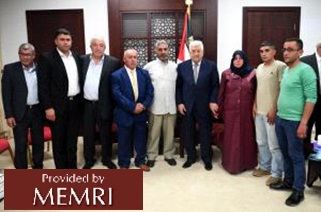 Delegation of prisoner’s families received at the Muqata’a (Wafa.ps, April 28, 2017)
Delegation of prisoner’s families received at the Muqata’a (Wafa.ps, April 28, 2017)
Praise for the prisoners was also heard from other senior PA and Fatah officials. On April 24, a delegation including Deputy Fatah Chairman Mahmoud Al-’Aloul and Central Committee member Jamal Al-Muheisen visited the home of Latifa Abu Hamid in the Al-Am’ari refugee camp, in recognition of her hunger strike in solidarity with her sons. Al-’Aloul promised that „Fatah will continue the struggle until all the prisoners are released.”[29]
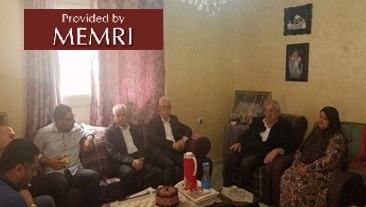 Fatah members on a visit to Latifa Abu Hamid’s home (pnn.ps/news, April 24, 2017)
Fatah members on a visit to Latifa Abu Hamid’s home (pnn.ps/news, April 24, 2017)
PA Prime Minister: „We Are Proud Of The Strike Led By 'The Fighter’ Marwan Al-Barghouti
PA Prime Minister Rami Al-Hamdallah joined those glorifying the terrorists in his speech to mark Palestinian Prisoner Day, when he referred to Marwan Al-Barghouti a „fighter.” He said: „The steadfastness of the prisoners’ movement and its sacrifices are a source of honor and pride for us. We, the leadership and the people, are united in supporting you and proud of the battle for freedom that you are waging, led by the fighter Marwan Al-Barghouti.[30]
Also, at the close of a PA government meeting on May 23, the day that Trump visited Bethlehem, the government congratulated „the heroic prisoners in Israel’s prisons and detention centers who demonstrate through the Battle for Freedom and Honor [i.e. the hunger strike] the greatest and most noble courage and sacrifice.” The government condemned „the silence of the international community and human rights, humanitarian and health organizations whose activities do not properly address the dangers facing the heroic prisoners… This dossier must be closed and it will be closed only when all the prisoners are released from the prisons of the occupation. Their freedom is inseparable from the liberation of the homeland and the people… Prime Minister [Rami Al-Hamdallah] has called on the public to increase its solidarity with the prisoners every day.”[31]
PA, Fatah, Israeli Arab Representatives Attend Inauguration Of Square Named For Terrorist Karim Younes
As part of activities in honor of the prisoners, on May 18, 2017 the PA named a square in Jenin after Israeli Arab terrorist Karim Younes, also known as the eldest of prisoners, who was convicted of the kidnapping and murder of the soldier Avraham Bromberg in 1980 and is serving a 40-year prison sentence. The Fatah movement in Jenin and the Jenin municipality invited dignitaries from the area as well as Israeli Arab figures to attend the inauguration in solidarity with the „heroic” prisoners. Jenin Governor Ibrahim Ramadan said at the ceremony that PA President Mahmoud 'Abbas is working for the release of the prisoners incarcerated in Israel. In another tribute to Karim Younes, in May the Fatah Central Committee decided to accept the recommendation of the movement’s Revolutionary Council and appoint him a member of the Central Committee.[32]
In Article, PA Prisoner Authority Chairman Calls To Take Up Arms: „Break Your Pens, Look For A Gun And A Bullet”
In an article he published in the Al-Quds daily, PA Prisoners Authority chairman 'Issa Qaraqe’ called on Palestinians to take up arms: „Do not cause us to get back [our prisoners] from the occupation’s prisons [in the form of] dead bodies. We are out of words. There is no more need for the press and the media, for analyses and projections. The prisoners are facing death now. Break your pens, look for a gun and a bullet… We already know where we will die – either in jail or executed at a checkpoint… They drag us to their military courts, to accuse us of whatever they like and declare they have caught us as terrorists. Enough. Each and every one of us must look for a gun and a bullet.”[33]
During the prisoners’ hunger strike, severe complaints were also heard against the Red Cross in Hebron and shots were even fired at the organization’s headquarters in the city. Al-Barghouti’s attorney, Elias Sabbagh, said that the Red Cross had violated one of its own principles – protecting prisoners – when it reduced the number of visits to which prisoners were entitled.[34] On May 16 the organization suspended its activities due to the threats it had received regarding the prisoners’ strike.[35]
Support For Continued Payments To Families Of Martyrs, Prisoners, Wounded
During the hunger strike, Fatah officials expressed support for the continued payment of allowances to the families of Palestinians who were imprisoned, killed or wounded as part of the struggle against Israel. Central Committee member 'Azzam Al-Ahmad said: „Seeing to the livelihood of the families of the martyrs has been a permanent part of the history of the [Palestinian] revolution, and we cannot renege on that… We will not allow Israel to interfere in this… The [Palestinian] National Fund is a PLO institution, and the U.S. administration has not asked us to halt the payments to [the families of] the martyrs, prisoners and wounded. Our position on this is based on the interest of our people.”[36]
'Abbas’s foreign affairs advisor, Nabil Sha’th, told Israeli radio that anyone asking the PA to halt the payments to prisoners is a madman, and that „this demand is meant destroy any chance for peace between the Palestinians and Israelis and is an act of defiance against the opportunity led by [U.S.] President Trump. The prisoners are victims of Israel and a result of the occupation. Would we ask Israel to stop paying salaries to its soldiers?”[37]
Extensive And Supportive Coverage Of The Strike In PA Press
As stated, the PA dailies covered the prisoners’ strike extensively with front-page headlines, articles, images and cartoons, presenting the prisoners as suffering victims and ignoring the brutal nature of the actions of which they had been convicted. Every day, Al-Hayat Al-Jadida reported, on its front page, the number of days of the hunger strike, and referred to the prisoners as „the heroes of freedom and honor.”[38]
 Al-Hayat Al-Jadida front page on 41st day of the strike
Al-Hayat Al-Jadida front page on 41st day of the strike
Articles Glorifying Murderers Serving Life Sentences
PA papers published dozens of articles about prisoners who had murdered Israelis, including many civilians. For example, a series of articles published by Al-Hayat Al-Jadida, some of them in collaboration with the Abu Jihad Center for Prisoner Affairs, included an article on Al-Aqsa Martyrs Brigades Commander Nasser 'Awais, who was sentenced to 14 terms of life imprisonment plus 50 years and six months for planning and carrying out terrorist attacks in 2001-2002, in which 14 Israelis were killed. Recounting his biography, the article states that from the age of 16 he threw firebombs at Israeli targets, and later recruited people to Fatah and commanded a group of fighters. After he was arrested and sentenced to five years, he became a central activist in prison. The article also describes his activity during the first intifada, his expulsion to Jordan for three years, his activity as commander of the Al-Aqsa Martyrs Brigades, which placed him at the top of Israel’s most wanted list, and his activity in Fatah’s Al-Shabiba movement. It notes that he did not recognize the legitimacy of the Israeli courts and mentions his pedigree as „the brother of a martyr and the uncle of a martyr.”[39]
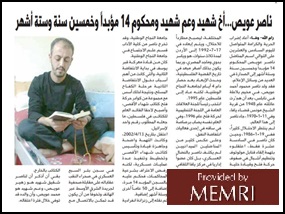 Al-Hayat Al-Jadida article on Nasser 'Awais
Al-Hayat Al-Jadida article on Nasser 'Awais
Another Al-Hayat Al-Jadida article was dedicated to the prisoner Hatem Yasser Muhammad Al-Jayousi, a founder of the Al-Aqsa Martyrs Brigades, who was sentenced to six terms of life imprisonment plus 55 years for planning a shooting attack during the second intifada in which six Israelis were killed. Recounting his life story and his armed operations, the article described him as „a resistance fighter who stands fast in the face of [his] jailor.”[40] A third article described the „heroism” of the prisoner 'Izz Al-Din Al-Khaled Hamamra, of the Deheishe refugee camp, who was sentenced to nine terms of life imprisonment for committing a suicide bombing during the second intifada in which eight Israelis were killed, and for planning bus hijacking operations.[41]
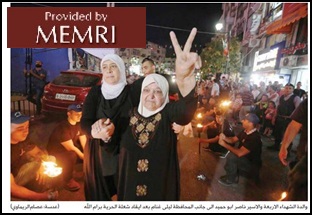 Latifa Abu Al-Hamid makes the sign of victory (image: Al-Hayat Al-Jadida, May 15, 2017)
Latifa Abu Al-Hamid makes the sign of victory (image: Al-Hayat Al-Jadida, May 15, 2017)
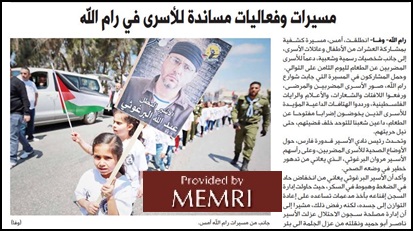 March in Ramallah in support of the prisoners’ strike. The girl is holding a portrait of prisoner 'Abd Allah Al-Barghouti, sentenced to 67 years for planning terrorist operations in which 66 people were killed in 2001-2002 (image: Al-Hayat Al-Jadida, PA, April 25, 2017)
March in Ramallah in support of the prisoners’ strike. The girl is holding a portrait of prisoner 'Abd Allah Al-Barghouti, sentenced to 67 years for planning terrorist operations in which 66 people were killed in 2001-2002 (image: Al-Hayat Al-Jadida, PA, April 25, 2017)
Articles Praising Academic Studies Of Prisoners Held By Israel
In the context of the demand to reinstate academic studies for prisoners, the Palestinian media highlighted personal stories of prisoners and their studies during their incarceration, in order to raise public awareness of the issue. For example, an article published by the Palestinian news agency Wafa about the prisoner Alaa Al-Din Al-Karaki, who was sentenced to life imprisonment for the murder of an Israeli, noted that he had completed a BA in political science and social sciences, with honors, and that when his mother visited him in prison he presented her with his academic degree and told her, „Mother, you planted a tree, and now the time has come for you to pick its fruit.”[42]
Another article was devoted to life prisoner Jum’a Adam, who while in prison completed his studies for a matriculation certificate and a bachelor’s degree, and is now studying by correspondence for a master’s at Al-Quds University, in the Department of Israeli Affairs.[43]
*C. Jacob is a research fellow at MEMRI.
[1] On the rivalry between 'Abbas and Al-Barghouti, see MEMRI Special Dispatch No. 6376, Special Dispatch No. 6376 – Marwan Barghouti: End Security Coordination With The Occupation, Strive For Comprehensive Intifada, April 6, 2016.
[2] See MEMRI Special Dispatch No. 6819, Palestinian President 'Abbas Meets With Terrorists And Terrorists’ Families, March 8, 2017.
[3] Amad.ps, May 25, 2017.
[4] A-Hayat Al-Jadida (Palestinian Authority), May 12, 2017.
[5] Maannews.net, May 23, 2017.
[6] Al-Ayyam (PA), May 29, 2017.
[7] Al-Hayat Al-Jadida (PA), April 19, 2017.
[8] Al-Hayat Al-Jadida (PA), April 18, 2017.
[9] Amad.ps. April 23, 2017.
[10] Fatehmedia.net, April 19, 2017.
[11] Wafa.ps, April 25, 2017.
[12] Al-Yawm Al-Sabi’ (Egypt), April 20, 2017.
[13] Asravoice.ps, April 16, 2017.
[14] Maannews.net, April 23, 2017.
[15] See MEMRI Special Dispatch No. 6376, Special Dispatch No. 6376 – Marwan Barghouti: End Security Coordination With The Occupation, Strive For Comprehensive Intifada, April 6, 2016.
[16] Wafa.ps, February 2, 2017.
[17] Maannews.net, April 19, 2017.
[18] Al-Ayyam (PA), April 17, 2017.
[19] Amad.ps, April 17, 2017.
[20] Wafa.ps, April 17, 2017.
[21] Al-Ayyam (PA), April 18, 2017.
[22] Osama Al-Fara, a member of the pro-Dahlan faction, wrote that Al-Barghouti’s incarceration does not prevent him from serving as Fatah deputy chairman, given his popularity in the movement, his success in the Central Committee elections, and his status as a symbol of the prisoners’ struggle. He added that nominating him Fatah deputy chairman could help pressure Israel to release him (amad.ps, February 23, 2017).
[23] See MEMRI Special Dispatches: No. 6376, Special Dispatch No. 6376 – Marwan Barghouti: End Security Coordination With The Occupation, Strive For Comprehensive Intifada, April 6, 2016; No. 6689, Muhammad Dahlan: I Don’t See Myself As A Presidential Candidate – I Support Marwan Barghouti , November 23, 2016.
[24] Al-Hayat Al-Jadida (PA), May 3, 2017.
[25] Further information on Latifa Al-Hamid’s sons: A third son, 'Abd Al-Mun’im, was a member of Hamas’s military wing, the 'Izz Al-Din Al-Qassam Brigades, in the West Bank, and was involved in the murder of three Israelis there in 1990 and of another in 1994.
The aforementioned Nasser Abu Hamid was one of the founders of Fatah’s military wing, the Al-Aqsa Martyrs Brigades, and was in charge of its Ramallah branch during the second intifada. In that period he was also an assistant to Marwan Al-Barghouti, then Fatah’s secretary-general in the West Bank. He was convicted in 1990 of the murder of four Israelis, but was released as part of the Oslo Accords. He was later convicted of the murder of seven other Israeli civilians in four separate attacks in 2000-2002 – the last of these attacks was at the Sea Food Market restaurant in Tel Aviv – and of 12 attempted murders, and was sentenced to seven life sentences plus another 50 years.
The aforementioned Sharif Abu Hamid was active in the Al-Aqsa Martyrs Brigades and also served in the PA Preventive Security Force. According to posts on the Hamas forum Paldf.net, he supplied weapons for a terror attack in a Jerusalem bus stop on February 25, 2002, and was also involved in the Sea Food Market attack in Tel Aviv several days later, on March 5, 2002, in which three Israelis were killed. He is serving four life sentences. A fourth son, Muhammad Abu Hamid, is serving two life sentences plus 30 years for planning suicide attacks as part of his activity in the Al-Aqsa Martyrs Brigades.
Latifa Abu Hamid has been dubbed „the Khansa of Palestine,” after early Islamic poet Khansa bint 'Omar, the „Mother of the Martyrs,” who did not mourn the death of her four sons in battle but rather thanked Allah for honoring her with their martyrdom.
Al-Hayat Al-Jadida (PA), May 10, 2017; alqassam.ps, no date; youtube.com, January 7, 2014; Facebook.com/We.are.Handala, April 18, 2012; mako.co.il, October 11, 2011; felesteen.ps, May 4, 2017; paldf.net/forum, July 31, 2003; alwatanvoice.com, May 12, 2013.
[26] Wafa.ps, April 28, 2017.
[27] Wafa.ps, April 28, 2017.
[28] Wafa.ps, April 25, 2017.
[29] Palsawa.com, April 25, 2017.
[30] Wafa.ps, April 16, 2017.
[31] Wafa.ps, May 23, 2017.
[32] Alquds.com, May 27, 2017.
[33] Al-Quds (Jerusalem), May 25, 2017.
[34] Al-Hayat Al-Jadida (PA), April 18, 2017.
[35] Alquds.com, May 16, 2017.
[36] Wafa.ps, April 27, 2017.
[37] Al-Quds (Jerusalem), May 5, 2017.
[38] A-Hayat Al-Jadida (Palestinian Authority), May 12, 2017.
[39] Wafa.ps, May 13, 2017.
[40] Al-Hayat Al-Jadida (PA), May 19, 2017.
[41] Wafa.ps. May 3, 2017.
[42] Wafa.ps, May 23, 2017.
[43] Al-bayader.org, May 22, 2017.
If you wish to reply, please send your email to memri@memrieurope.org.






